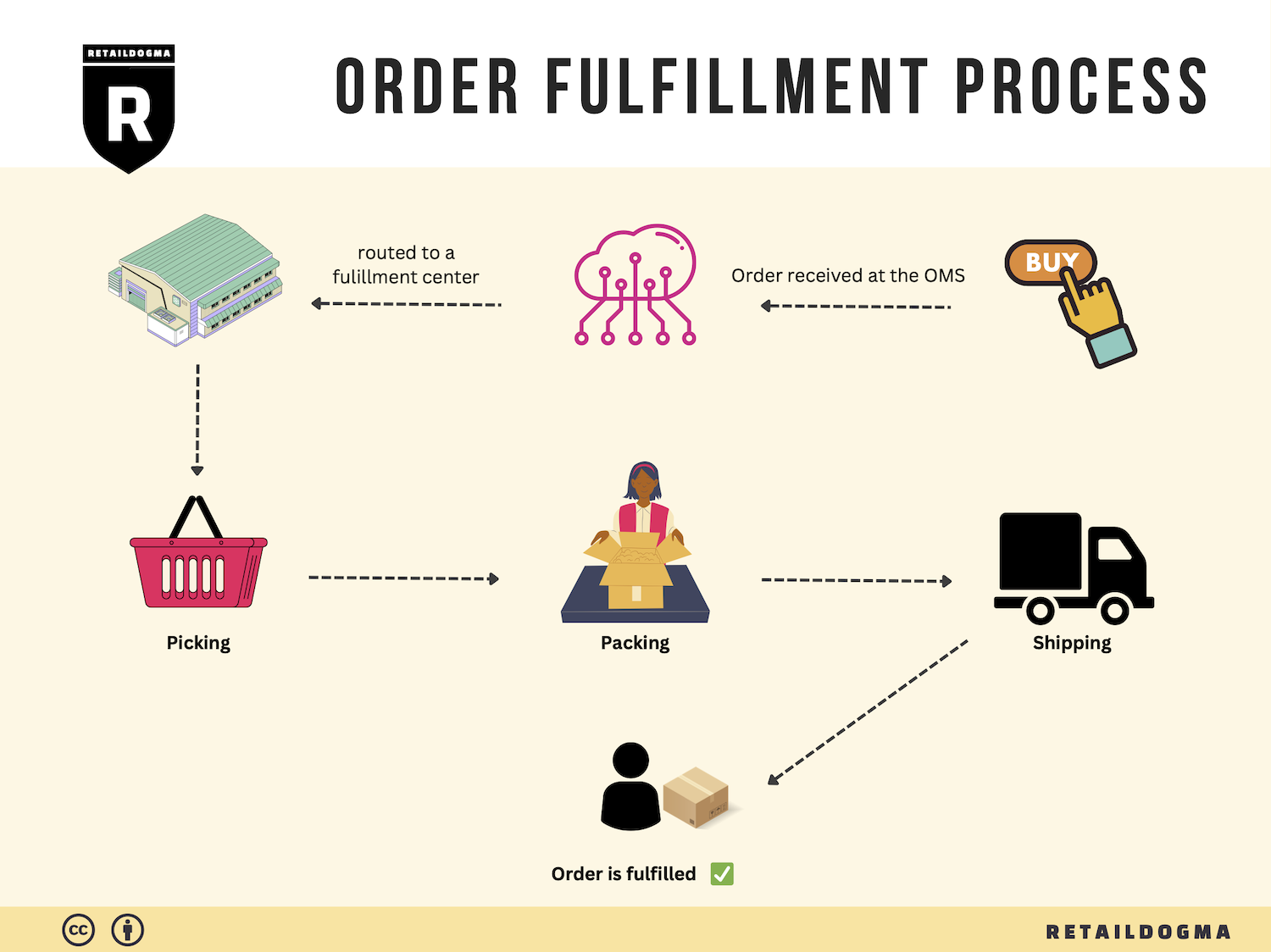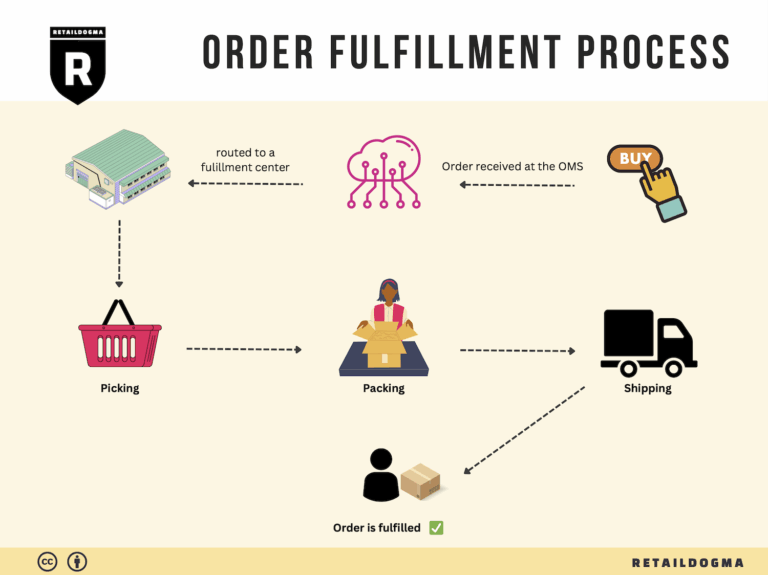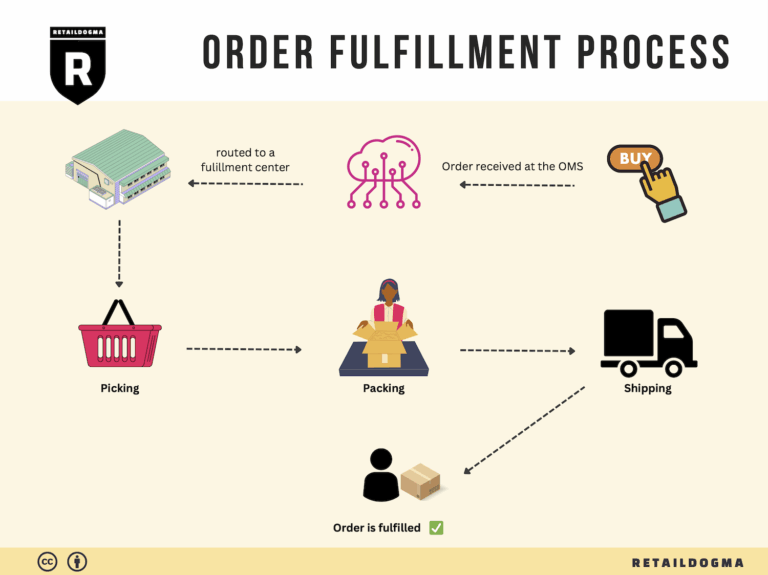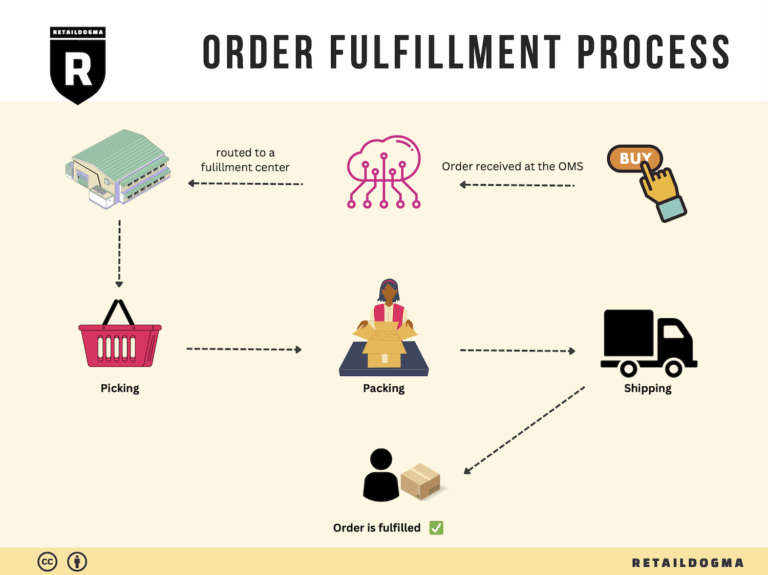What Is A Fulfillment Center? A Complete Guide (2025)
What is E-commerce Fulfillment? An Introduction for Growing Businesses
Understanding E-commerce Fulfillment: A Key to Scaling Your Business
As an e-commerce business owner or operations manager, you may find yourself grappling with a common challenge: the overwhelming burden of packing and shipping orders. As sales grow, so do the complexities of logistics. Efficiently managing the process of getting products from your warehouse to your customers can quickly become a daunting task. This is where e-commerce fulfillment comes into play.
E-commerce fulfillment is simply the process of storing, packing, and shipping products to customers after an order is placed. It encompasses everything from inventory management to order processing and shipping logistics. For businesses looking to scale, understanding the intricacies of fulfillment is crucial to maintaining customer satisfaction and operational efficiency.
In this guide, we will delve into the various models of e-commerce fulfillment, including Third-Party Logistics (3PL) and Fulfillment by Amazon (FBA). Each model has its unique advantages and drawbacks, and knowing which one aligns best with your business goals can significantly impact your growth trajectory.
We will also explore the core services that fulfillment partners typically offer, such as inventory management, order processing, shipping, returns handling, and customer service. These services are vital in ensuring that your customers receive their orders promptly and in excellent condition, which in turn fosters loyalty and repeat business.
Choosing the right fulfillment partner is another critical aspect we will cover. The right partner can streamline your operations, reduce shipping times, and enhance the overall customer experience. We will provide practical tips on what to look for in a fulfillment partner, including technology capabilities, scalability, and customer service support.
Pricing is an essential consideration in the fulfillment process, and we will break down the various costs associated with different fulfillment models. Understanding these costs will help you budget effectively and make informed decisions that align with your financial goals.
Ultimately, this guide aims to empower you with the knowledge and tools necessary to make smart decisions about your logistics strategy. By gaining a comprehensive understanding of e-commerce fulfillment, you can enhance your operational efficiency, improve customer satisfaction, and drive sustainable growth for your business.
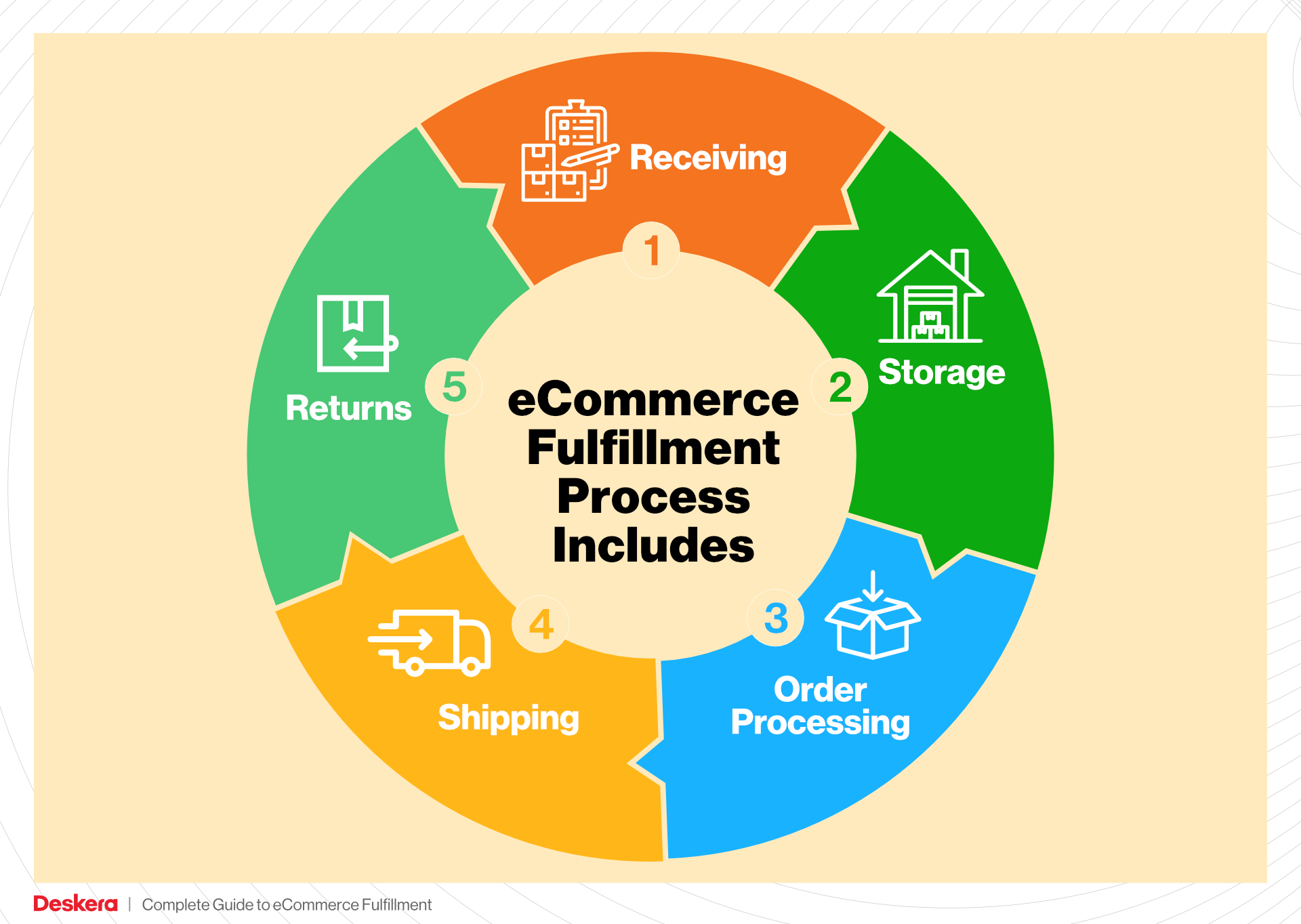
What You’ll Learn In This Guide
- What is E-commerce Fulfillment? An Introduction for Growing Businesses
- The Order Fulfillment Process: From ‘Buy’ Button to Customer’s Door
- Comparing Fulfillment Models: In-House vs. 3PL vs. Dropshipping
- A Deep Dive into Amazon FBA: Pros, Cons, and Who It’s For
- Core Services Offered by Fulfillment Centers
- How to Choose a Fulfillment Partner: A 6-Point Checklist
- Understanding Fulfillment Pricing: A Breakdown of Common Fees
- Frequently Asked Questions (FAQs) about Fulfillment
- Conclusion: Is Outsourcing Fulfillment the Right Move for Your Business?
- Important Disclaimer
The Order Fulfillment Process: From ‘Buy’ Button to Customer’s Door
1. Receiving Inventory
The order fulfillment process begins with receiving inventory at the fulfillment center. This step involves checking the incoming shipments against purchase orders to ensure that the right items and quantities have arrived. Each product is assigned a unique Stock Keeping Unit (SKU), which aids in tracking and inventory management.
Importance: Proper receiving is crucial to maintaining accurate inventory levels, which directly impacts order fulfillment efficiency. Any discrepancies can lead to stockouts or excess inventory, both of which can harm customer satisfaction and increase operational costs.
Key Term: SKU (Stock Keeping Unit) – A unique identifier for each product, enabling efficient tracking and management of inventory.
2. Warehouse Storage
Once the inventory is received and verified, it is then stored in the warehouse. This process typically involves placing items in designated locations based on their SKU, size, and demand. Efficient warehouse layout and organization are essential for maximizing space and facilitating easy access to products.
Importance: Effective warehouse storage minimizes retrieval time during the order picking process. A well-organized warehouse also reduces the risk of errors, such as picking the wrong item, which can lead to customer dissatisfaction and increased returns.
Key Term: Warehouse Management System (WMS) – Software that helps manage inventory levels, storage locations, and retrieval processes, ensuring optimal organization and efficiency.
3. Order Picking
When a customer places an order, the next step is order picking. This involves retrieving the items from their storage locations based on a pick list generated by the WMS. The pick list outlines the SKUs, quantities, and locations of the items needed for the order.
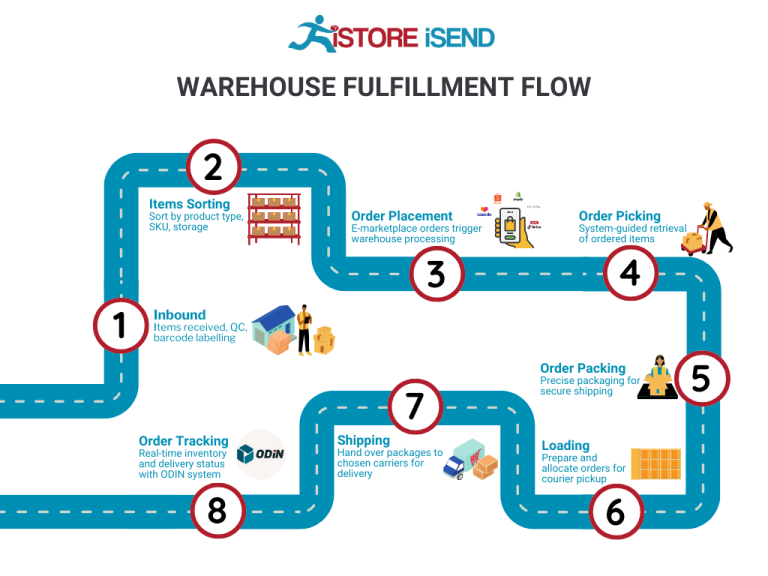
Importance: Order picking is one of the most labor-intensive parts of the fulfillment process. Efficient picking strategies, such as batch picking or zone picking, can significantly reduce processing times and increase throughput, allowing businesses to fulfill orders more quickly.
Key Term: Pick List – A document or digital list that guides warehouse staff in collecting the items needed to fulfill a specific order.
4. Order Packing
After the items have been picked, they move to the packing station. Here, the products are carefully packed into boxes or bags, ensuring that they are protected during transit. The packing process also includes labeling the packages with shipping information and any necessary documentation, such as invoices.
Importance: Proper packing is essential to prevent damage during shipping and to ensure that the correct items are sent to customers. High-quality packing materials and processes can enhance the customer experience and reduce return rates due to damaged goods.
Key Term: Packing Slip – A document that accompanies a shipment, detailing the items included in the package, which helps ensure accuracy and accountability.
5. Shipping & Delivery
The final step in the order fulfillment process is shipping and delivery. Once packed, orders are handed over to shipping carriers for delivery to the customer’s address. This step involves selecting the appropriate shipping method based on factors like cost, delivery speed, and destination.
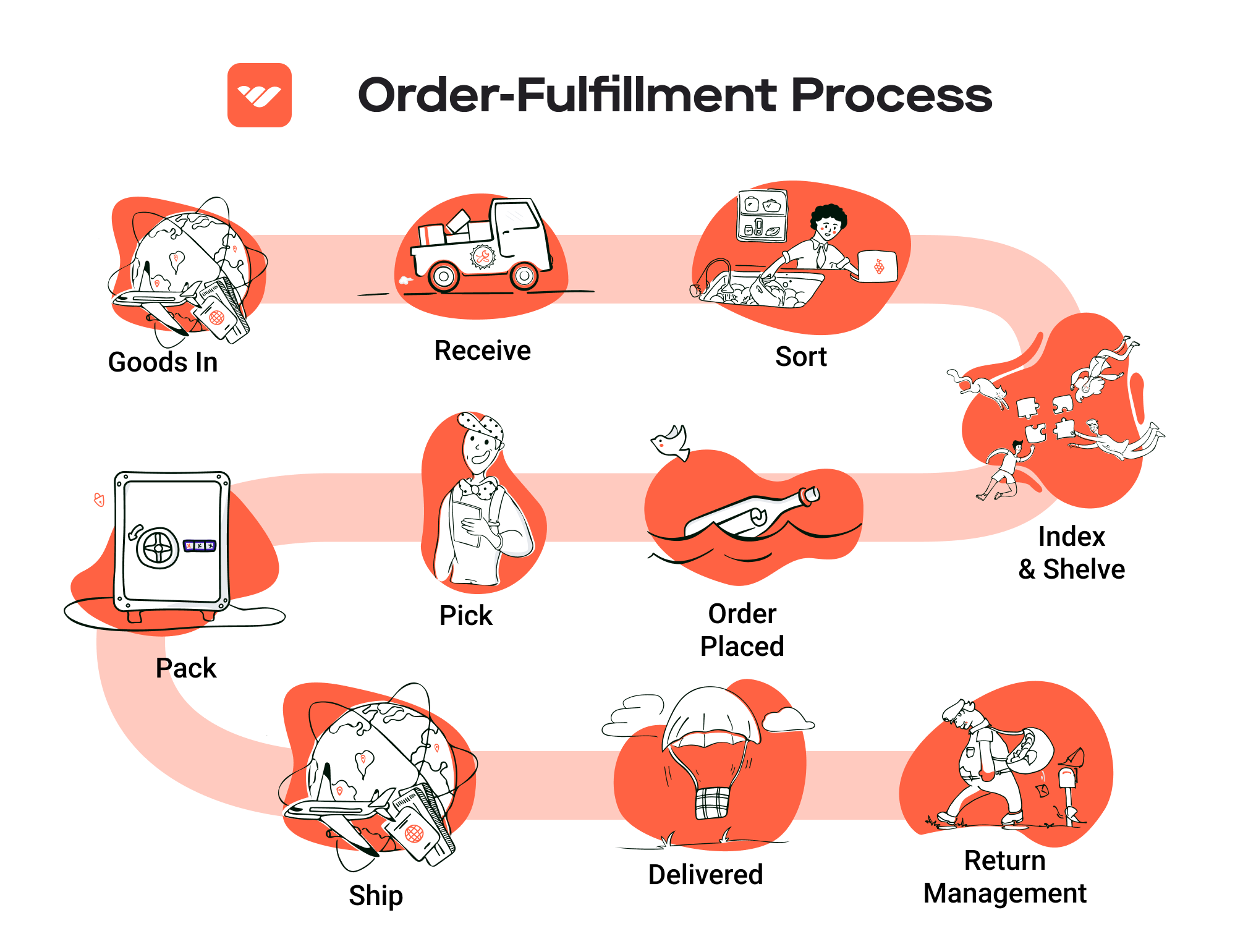
Importance: Timely and accurate shipping is critical to customer satisfaction. Customers expect fast delivery, and any delays can lead to dissatisfaction and potential loss of future business. Effective logistics management, including tracking shipments and handling returns, is vital for maintaining a positive customer relationship.
Key Term: Last-Mile Delivery – The final step in the shipping process, where the package is delivered from a distribution center to the end customer, often seen as the most critical aspect of logistics.
In conclusion, understanding and optimizing each step of the order fulfillment process is essential for e-commerce businesses looking to scale operations efficiently. By focusing on effective inventory management, warehouse organization, order picking strategies, packing quality, and shipping logistics, companies can enhance their overall fulfillment capabilities, leading to improved customer satisfaction and increased sales.
Comparing Fulfillment Models: In-House vs. 3PL vs. Dropshipping
Fulfillment Model Comparison
| Model | Who Handles Inventory | Best For (Business Stage) | Key Advantage | Key Disadvantage |
|---|---|---|---|---|
| In-House Fulfillment | Business itself | Established businesses | Full control over inventory and processes | High overhead costs and operational complexity |
| Third-Party Logistics (3PL) | Third-party provider | Growing businesses | Scalability and reduced operational burden | Less control over inventory management and shipping |
| Dropshipping | Supplier or manufacturer | Startups and small businesses | Low upfront costs and minimal risk | Lower profit margins and less control over product quality |
In-House Fulfillment
In-house fulfillment is a model where a business manages its own inventory, warehousing, and order processing. This approach is often favored by established companies that have the resources and infrastructure to handle logistics internally. The primary advantage of in-house fulfillment is the complete control it offers over inventory management, order processing, and customer service. This control can enhance brand consistency and customer experience, as businesses can customize their fulfillment processes to align closely with their brand values and customer expectations. However, the downsides include significant overhead costs, as businesses must invest in warehouse space, staffing, technology, and equipment. Additionally, operational complexity can increase as the business scales, requiring a sophisticated logistics strategy and management capabilities.
Third-Party Logistics (3PL)
Third-party logistics (3PL) refers to outsourcing logistics operations to a specialized provider. This model is ideal for growing businesses that need to scale their operations without the burden of managing logistics in-house. 3PL providers handle everything from warehousing and inventory management to shipping and returns, allowing businesses to focus on their core competencies, such as marketing and product development. The key advantage of using a 3PL is scalability; businesses can quickly adapt their logistics capabilities to meet changing demand without significant upfront investments. However, a notable disadvantage is the potential loss of control over inventory management and customer service. Businesses must rely on the 3PL’s processes and systems, which may not always align perfectly with their own operational standards or customer expectations.
Dropshipping
Dropshipping is a fulfillment model where a business sells products without holding inventory. Instead, when a customer places an order, the business purchases the item from a third-party supplier who then ships it directly to the customer. This model is particularly attractive for startups and small businesses due to its low upfront costs and minimal financial risk. Entrepreneurs can launch their e-commerce stores without the need for significant investment in inventory or warehousing. However, dropshipping comes with its own set of challenges. One major disadvantage is the lower profit margins, as the retailer often has to pay a premium for the convenience of not holding stock. Additionally, businesses have less control over product quality and shipping times, which can lead to customer dissatisfaction if the supplier fails to meet expectations. This lack of control can pose significant risks to brand reputation, particularly in a market where customer experience is paramount.
Conclusion
Choosing the right fulfillment model is crucial for e-commerce success and should align with a business’s specific needs, resources, and growth stage. While in-house fulfillment offers control and customization, it comes with high operational costs. On the other hand, 3PL provides scalability and efficiency but at the cost of some control. Finally, dropshipping presents an accessible entry point for new businesses but can lead to challenges with margins and quality assurance. E-commerce business owners must carefully weigh these factors to select the model that best supports their operational goals and customer satisfaction.
A Deep Dive into Amazon FBA: Pros, Cons, and Who It’s For
Understanding Fulfillment by Amazon (FBA)
Fulfillment by Amazon (FBA) is a service offered by Amazon that allows e-commerce sellers to store their products in Amazon’s fulfillment centers. In turn, Amazon takes care of the storage, packaging, and shipping of these products, as well as handling customer service and returns. This service is designed to streamline the logistics and operational challenges that sellers face, enabling them to focus on growing their businesses.
How FBA Works
When a seller enrolls in FBA, they send their products to Amazon’s fulfillment centers. Once the products are in the warehouse, Amazon’s sophisticated inventory management system takes over. Here’s a step-by-step breakdown of how the process works:
-
Product Listing: Sellers create listings for their products on Amazon. They can choose to enroll in FBA during this process.
-
Inventory Shipment: Sellers prepare their products for shipment to Amazon. This includes labeling and packaging according to Amazon’s guidelines.
-
Storage: Once received at the fulfillment center, products are stored until sold. Amazon uses a complex inventory management system to track stock levels and product locations.
-
Order Fulfillment: When a customer places an order, Amazon picks, packs, and ships the product directly to the customer. This includes handling all packaging and shipping logistics.
-
Customer Service: Amazon manages customer inquiries and returns, providing a seamless experience for both sellers and buyers.
-
Payment: After the sale is completed, Amazon transfers the proceeds to the seller’s account, minus applicable fees.
Pros of FBA
Prime Eligibility
One of the most significant advantages of using FBA is the ability for products to be eligible for Amazon Prime. This status often leads to increased visibility and sales, as millions of Prime members prefer items that offer fast, free shipping.
Customer Trust
Products fulfilled by Amazon benefit from the trust associated with the Amazon brand. Customers are more likely to purchase items that are backed by Amazon’s customer service and return policies, which can lead to higher conversion rates.
Multi-Channel Fulfillment
FBA is not limited to sales on Amazon alone. Sellers can use FBA to fulfill orders from other sales channels, including their own websites and other marketplaces. This flexibility allows businesses to streamline their logistics across multiple platforms.
Scalability
FBA allows sellers to scale their operations quickly. With Amazon handling logistics, sellers can focus on expanding their product lines and marketing efforts without being bogged down by fulfillment challenges.
Advanced Logistics
Amazon’s vast logistics network is equipped with advanced technology and processes that ensure fast and efficient order fulfillment. This includes automated warehousing systems and sophisticated shipping methods, which can enhance operational efficiency.
Cons of FBA
High Fees
While FBA provides many benefits, the associated costs can be significant. Sellers incur storage fees for keeping their products in Amazon’s warehouses, as well as fulfillment fees for each order shipped. These costs can eat into profit margins, especially for low-cost items.
Strict Inventory Rules
Amazon has stringent inventory management rules, including requirements for labeling, packaging, and shipping. Sellers must adhere to these guidelines to avoid penalties, which can be a burden for those unfamiliar with the system.
Commingling Risks
FBA utilizes a process called commingling, where products from different sellers are stored together. This can pose risks, as sellers are responsible for the quality and condition of the items sent to customers. If a customer receives a defective product from another seller, it can reflect poorly on the original seller.
Limited Control
Once products are sent to Amazon, sellers relinquish control over the fulfillment process. This includes aspects such as packaging and shipping methods, which may not align with the seller’s brand standards.
Inventory Management Challenges
Managing inventory levels can be complex with FBA, particularly with Amazon’s fluctuating storage fees and the potential for long-term storage fees if items do not sell quickly. Sellers must carefully monitor stock levels to avoid unnecessary costs.
Who is FBA Best For?
Fulfillment by Amazon is particularly well-suited for:
-
Small to Medium-Sized Businesses: Businesses looking to scale quickly without investing heavily in their own logistics infrastructure can benefit significantly from FBA.
-
Sellers with High-Volume Sales: Those who anticipate high sales volumes can take advantage of the efficiencies that FBA offers, making it easier to handle large order quantities.
-
E-commerce Entrepreneurs: New sellers can leverage Amazon’s established platform and customer base to gain visibility and trust quickly.
-
Sellers Focused on Growth: Businesses aiming to expand into new markets or product lines can use FBA to minimize operational burdens, allowing them to focus on marketing and product development.
-
Brands Seeking Prime Eligibility: Companies looking to reach Amazon’s Prime customer base can benefit from the increased sales potential associated with FBA.
In conclusion, while Fulfillment by Amazon offers numerous advantages, such as increased visibility and streamlined logistics, it also presents challenges that sellers must navigate. Understanding both the pros and cons of FBA is essential for e-commerce businesses looking to optimize their operations and maximize their sales potential.
Core Services Offered by Fulfillment Centers
Inventory Management & Warehousing
Inventory management and warehousing are foundational components of fulfillment center operations. This service involves the systematic tracking of inventory levels, orders, sales, and deliveries. Fulfillment centers utilize advanced inventory management software that provides real-time data on stock levels, enabling businesses to make informed decisions about restocking and inventory turnover.
The benefits of efficient inventory management are manifold. For e-commerce businesses, having accurate inventory counts reduces the risk of stockouts or overstock situations. Stockouts can lead to lost sales and dissatisfied customers, while overstocking ties up capital that could be better utilized elsewhere. Moreover, effective inventory management allows businesses to optimize storage space and reduce holding costs, ultimately enhancing operational efficiency and profitability.
Pick and Pack Services
Pick and pack services are integral to the order fulfillment process. This service involves selecting (picking) the correct items from the warehouse based on customer orders and then preparing (packing) these items for shipment. Fulfillment centers typically employ a systematic approach, using barcodes or RFID technology to ensure accuracy during the picking process. Once items are picked, they are packed using appropriate materials to prevent damage during transit.
For e-commerce businesses, the primary advantage of pick and pack services is speed and accuracy. Quick fulfillment times can significantly enhance customer satisfaction, which is essential in a competitive online marketplace. Additionally, accuracy in picking reduces returns and exchanges, further streamlining operations. By outsourcing pick and pack services to a fulfillment center, businesses can focus on core activities like marketing and product development, while ensuring that their customers receive the right products promptly.
Kitting and Assembly
Kitting and assembly refer to the process of grouping individual items into a single package or assembling products before they are shipped to the customer. This service is particularly beneficial for businesses that offer bundled products or require assembly before shipping, such as furniture or electronics. Fulfillment centers often have the capability to customize kits based on specific customer needs, which can include promotional items or seasonal offerings.
The key benefits of kitting and assembly services are enhanced customer experience and operational efficiency. By providing customers with pre-assembled products or tailored kits, businesses can increase perceived value and drive higher sales. Moreover, kitting can streamline the packaging process, reducing the time and resources needed to prepare items for shipment. This results in cost savings and improved order accuracy, as fulfillment centers are equipped to handle these processes efficiently.
Returns Management (Reverse Logistics)
Returns management, often referred to as reverse logistics, is a critical service offered by fulfillment centers. This process involves handling product returns from customers, which includes inspecting returned items, processing refunds or exchanges, and restocking inventory. Effective returns management is essential for maintaining customer satisfaction and loyalty, as hassle-free return processes can enhance the overall shopping experience.
For e-commerce businesses, the benefits of a well-organized returns management system are substantial. First, it allows for a streamlined approach to handling returns, reducing the time and resources spent on processing them. Second, a robust returns process can help businesses identify patterns in returns, providing valuable insights into product quality and customer preferences. This information can be used to improve product offerings and reduce return rates in the future. Furthermore, by leveraging a fulfillment center’s expertise in reverse logistics, businesses can enhance their reputation for customer service, which can lead to increased customer retention and repeat sales.
Conclusion
In summary, fulfillment centers offer a suite of core services that are essential for e-commerce businesses looking to scale their operations. From inventory management and warehousing to pick and pack services, kitting and assembly, and returns management, these services are designed to improve efficiency, enhance customer satisfaction, and ultimately drive profitability. By partnering with a fulfillment center, e-commerce businesses can focus on their growth strategies while relying on experts to handle the complexities of logistics and order fulfillment. This strategic partnership can be a game-changer in today’s fast-paced e-commerce landscape.
How to Choose a Fulfillment Partner: A 6-Point Checklist
Location & Warehouse Network
The geographic positioning of your fulfillment partner’s warehouses is crucial for efficient logistics. A strategically located fulfillment center can significantly reduce shipping times and costs, which is essential for maintaining customer satisfaction.
Key Questions to Ask:
– Where are the fulfillment centers located? Are they close to your primary customer base?
– How many warehouses do they operate, and what is the network coverage?
– Do they have the capability to manage regional distribution effectively?
Having multiple fulfillment centers can help optimize shipping routes and reduce delivery times, particularly for e-commerce businesses like Rent the Runway, which cater to quick turnaround times for customer rentals.
Technology & Integrations
In today’s digital age, the technology stack of your fulfillment partner can make or break your logistics operations. A robust technological foundation allows for seamless order processing, inventory management, and real-time tracking.
Key Questions to Ask:
– What technology do you use for order management and inventory tracking?
– Can your systems integrate with our existing e-commerce platform?
– How do you handle data security and privacy?
Proprietary technologies, like those used by Rent the Runway, not only streamline operations but also enhance customer experience by providing visibility into order status and inventory availability. Ensure your partner is equipped with the latest technologies to stay competitive.
Specializations (e.g., cold storage, oversized items)
Different businesses have unique product requirements. Understanding whether your fulfillment partner has the necessary specializations can save you from logistical headaches down the line.
Key Questions to Ask:
– What types of products do you specialize in handling?
– Do you have facilities for specialized storage needs, such as cold storage for perishables or handling oversized items?
– Can you accommodate unique packaging requirements?
For a business like Rent the Runway, which deals with delicate designer garments, expertise in garment care and cleaning, alongside the ability to manage returns efficiently, is vital. Choose a partner whose capabilities align with your specific needs.
Scalability & Capacity
As your business grows, so will your fulfillment needs. Choosing a partner that can scale with you is essential to avoid disruptions in your supply chain.
Key Questions to Ask:
– What is your current capacity, and how quickly can you scale operations if demand increases?
– How do you handle peak seasons or unexpected spikes in order volume?
– Are there any restrictions on the types of products or volume you can handle?
A partner with a proven track record of scalability, like Rent the Runway’s automated facilities, can adapt to growth without compromising service levels. Ensure that your chosen partner can accommodate your future business goals.
Pricing and Contracts
Understanding the pricing structure and contract terms is vital for maintaining budget control. Hidden fees can quickly erode your profit margins, so clarity is key.
Key Questions to Ask:
– What is your pricing model (e.g., per order, storage fees, shipping costs)?
– Are there any additional fees we should be aware of?
– What are the terms for contract renewal or termination?
Transparent pricing structures can help you make informed financial decisions. Be wary of partners that are vague about costs. A well-defined contract is crucial for avoiding disputes and ensuring a smooth operational relationship.
Customer Support & Reviews
A responsive customer support team can be a game-changer when challenges arise. Evaluating customer feedback can also provide insights into the reliability of your potential partner.
Key Questions to Ask:
– What customer support channels do you offer (e.g., phone, email, live chat)?
– What is your average response time for support inquiries?
– Can you provide references or testimonials from other clients?
Researching customer reviews and testimonials can provide a glimpse into the partner’s reliability and service quality. A partner with a strong reputation for customer support can help you resolve issues quickly, minimizing disruptions in your operations.
In conclusion, selecting the right fulfillment partner is a critical decision that can affect the overall efficiency and scalability of your business. By carefully considering these six key areas and asking the right questions, you can identify a partner that aligns with your operational needs and business objectives. Remember, the goal is to find a partner that not only meets your current requirements but is also equipped to grow with you in the future.
Understanding Fulfillment Pricing: A Breakdown of Common Fees
Initial Setup Fees
Initial setup fees are typically incurred when you first engage with a fulfillment center. These fees cover the costs associated with onboarding your products into the facility’s system. This may include:
- Account Setup: Creating and configuring your business profile within the fulfillment center’s management software.
- Integration Costs: If you require software integrations (e.g., e-commerce platforms, inventory management systems), there may be fees for API setup or customization.
- Product Setup: This includes the initial data entry for your products, including descriptions, weights, dimensions, and SKU assignments.
The calculation of initial setup fees can vary widely based on the complexity of your product catalog and the fulfillment provider’s pricing structure. Some providers offer flat-rate fees, while others may charge based on the number of SKUs you wish to onboard.
Receiving Fees
Receiving fees are charged when your inventory arrives at the fulfillment center. These fees cover the labor and processes involved in unloading, inspecting, and entering your products into the inventory management system.
Key components of receiving fees include:
- Unloading Costs: Labor required to unload products from shipping containers or pallets.
- Inspection and Quality Control: Checking the products against purchase orders to ensure accuracy and quality.
- Data Entry: Entering product details into the inventory system for tracking and management.
Receiving fees are often calculated per pallet or per item, depending on the fulfillment center’s pricing model. Understanding these fees is crucial, as they can add up quickly, especially for businesses that frequently replenish inventory.
Storage Fees (per pallet/bin)
Storage fees are incurred for the physical space your inventory occupies within the fulfillment center. These fees can be charged on a per-pallet or per-bin basis, depending on how the facility is organized.
Considerations for storage fees include:
- Space Utilization: The amount of space your products take up, which can fluctuate based on seasonal inventory changes.
- Duration of Storage: Fees may be calculated monthly, with discounts often available for long-term storage commitments.
Storage fees can vary significantly by location and facility type. Understanding the layout and capacity of the fulfillment center will help you estimate these costs effectively.
Pick & Pack Fees (per item/order)
Pick and pack fees are charged for the labor involved in retrieving items from storage and preparing them for shipment. This process includes picking the correct items, packing them securely, and preparing them for dispatch.
Key factors influencing pick and pack fees include:
- Order Complexity: Fees may increase with the number of items per order or if special packing materials are required.
- Frequency of Orders: Some providers offer tiered pricing where costs decrease with higher order volumes.
Pick and pack fees are usually calculated per item or per order, so understanding your order patterns can help you negotiate better pricing.
Shipping Fees
Shipping fees are the costs associated with sending your products to customers. These fees can vary based on several factors:
- Carrier Choice: Different carriers (e.g., UPS, FedEx, USPS) have varying rates based on service levels (ground, express, etc.).
- Destination: Shipping costs can increase significantly for international orders or remote locations.
- Weight and Dimensions: Heavier or larger packages typically incur higher shipping charges.
Shipping fees may be calculated based on a combination of these factors, and many fulfillment centers offer discounted rates through partnerships with carriers. Understanding your shipping needs and options can lead to substantial cost savings.
Tips for Getting an Accurate Quote
-
Be Detailed: Provide comprehensive information about your products, order volumes, and special requirements. This will help fulfillment centers offer accurate pricing tailored to your needs.
-
Compare Multiple Quotes: Don’t settle for the first quote. Request estimates from multiple fulfillment providers to compare pricing structures and services.
-
Ask About Hidden Fees: Ensure you ask about any additional charges that may not be immediately apparent, such as rush fees, returns handling, or seasonal adjustments.
-
Review Terms and Conditions: Thoroughly review the fulfillment center’s terms, as these can significantly affect pricing and service levels.
-
Negotiate: Many fulfillment centers are open to negotiation, especially if you can demonstrate potential order volume or long-term commitment.
By understanding the common fulfillment pricing models and being diligent in your inquiries, you can better manage costs and find a fulfillment partner that aligns with your business goals.
Frequently Asked Questions (FAQs) about Fulfillment
1. What is a fulfillment center?
A fulfillment center is a specialized warehouse that manages the storage, packaging, and shipping of products on behalf of e-commerce businesses. Unlike traditional warehouses, fulfillment centers are designed to handle high volumes of orders efficiently, utilizing advanced technology and logistics systems to streamline the process from receiving inventory to delivering orders to customers.
2. How does Rent the Runway’s fulfillment center operate?
Rent the Runway’s fulfillment centers, located in Secaucus, New Jersey, and Arlington, Texas, utilize a combination of proprietary technology and reverse logistics to manage the rental process. Items are meticulously inspected, cleaned, and stored before being shipped to customers in reusable garment bags, with prepaid return labels included for easy returns. This seamless operation allows them to maintain a vast inventory while ensuring high-quality service.
3. What is the difference between a warehouse and a fulfillment center?
The primary difference lies in their functions. A warehouse is primarily for storage, focusing on holding inventory until it is needed. In contrast, a fulfillment center is geared towards order processing, including picking, packing, and shipping items directly to customers. Fulfillment centers are designed for speed and efficiency in order fulfillment, making them essential for e-commerce businesses.
4. What are the benefits of using a fulfillment center like Rent the Runway’s?
Using a fulfillment center provides several advantages:
– Efficiency: Streamlined processes for order fulfillment reduce shipping times.
– Scalability: Businesses can scale operations without the need for significant upfront investment in infrastructure.
– Quality Control: Rigorous inspection and cleaning protocols ensure product quality.
– Cost-Effectiveness: Reduces overhead costs associated with storage and labor for businesses.
5. What is a 3PL, and how does it relate to fulfillment centers?
A 3PL, or third-party logistics provider, is a company that offers outsourced logistics services, including warehousing, fulfillment, and shipping. Fulfillment centers can be part of a 3PL’s offerings, allowing e-commerce businesses to leverage specialized expertise and infrastructure for managing their supply chain efficiently.
6. How much do fulfillment services cost?
Fulfillment service costs can vary widely based on several factors, including the volume of orders, storage needs, and specific services required (like packing and shipping). Typically, fees include:
– Storage fees: Charged per pallet or cubic foot of space used.
– Pick and pack fees: Charged per order or item picked and packaged.
– Shipping fees: Based on weight, dimensions, and shipping method.
It’s essential for businesses to analyze their specific needs and request quotes from fulfillment providers to get an accurate estimate.
7. How does Rent the Runway ensure quality control in its fulfillment process?
Rent the Runway employs a dedicated garment science team to oversee the cleaning and inspection of all items. Each garment undergoes a rigorous quality check to ensure it is in excellent condition before being sent out. Their commitment to quality care helps maintain customer satisfaction and brand integrity.
8. What technology does Rent the Runway use in its fulfillment centers?
Rent the Runway leverages proprietary technology that supports inventory management, order processing, and reverse logistics. This includes automated systems for garment handling, tracking software for monitoring orders, and advanced cleaning technology that enhances efficiency and effectiveness in maintaining garment quality.
9. What are reverse logistics, and why are they important for Rent the Runway?
Reverse logistics refers to the process of moving goods from their final destination back to the manufacturer or fulfillment center for returns, repairs, or recycling. For Rent the Runway, effective reverse logistics are crucial because they facilitate the easy return of rented items, enabling faster turnaround times for cleaning and re-renting garments, which is essential for maintaining inventory flow and customer satisfaction.
10. How can businesses benefit from using Rent the Runway’s fulfillment services?
Businesses can benefit by accessing a vast inventory of designer clothing without the overhead costs associated with purchasing and maintaining such stock. Leveraging Rent the Runway’s established fulfillment processes allows businesses to offer rental options to their customers, enhancing their product offerings and appealing to the growing demand for sustainable fashion solutions. This can lead to increased sales and customer loyalty while minimizing inventory risks.
Conclusion: Is Outsourcing Fulfillment the Right Move for Your Business?
Key Benefits of Outsourcing Fulfillment
Outsourcing your fulfillment process can be a transformative decision for your e-commerce business. One of the most significant advantages is the time savings. By entrusting your logistics to a dedicated fulfillment center, you can focus on core business activities like marketing, product development, and customer engagement, rather than getting bogged down in the complexities of order processing and shipping.
Another essential benefit is scalability. As your sales increase, so do your fulfillment needs. A proficient fulfillment partner can seamlessly adjust to fluctuations in order volume, ensuring that you can meet customer demand without the headache of managing additional resources or infrastructure. This flexibility is crucial for businesses aiming to grow rapidly in a competitive e-commerce landscape.
Moreover, partnering with a fulfillment service brings expertise that can enhance your operational efficiency. These centers often employ advanced technologies and have established processes for inventory management, order processing, and returns. This expertise not only improves speed and accuracy but also enhances customer satisfaction—an essential factor for retaining loyalty in today’s market.
Choosing the Right Partner
However, the success of outsourcing hinges on selecting the right fulfillment partner. It’s vital to evaluate potential providers based on their capabilities, technology stack, and alignment with your business goals. A mismatch could lead to inefficiencies, increased costs, and ultimately, a negative impact on your brand reputation.
Strategic Call to Action
To determine if outsourcing fulfillment is the right strategic move for your business, start with an audit of your current shipping and logistics processes. Assess your order volume, fulfillment speed, customer feedback, and operational challenges. This analysis will help you identify whether a fulfillment partner could enhance your efficiency and support your growth objectives. Taking this proactive step could be the catalyst for taking your e-commerce business to the next level.
Important Disclaimer
⚠️ Important Disclaimer
The information in this guide is for educational purposes. Fulfillment services, pricing, and platform features change frequently. Always conduct your own due diligence and consult with providers directly before making business decisions.
